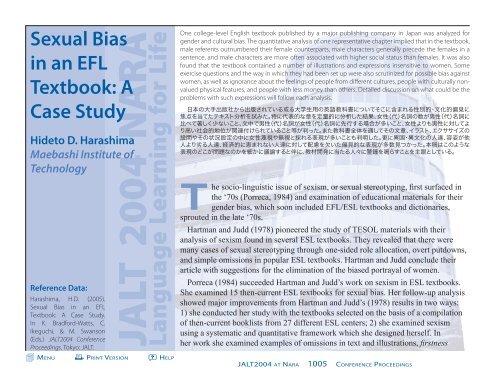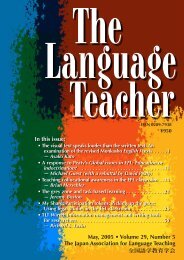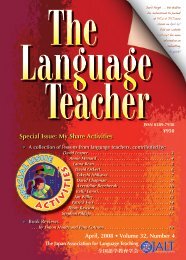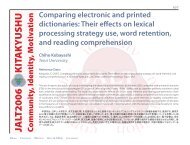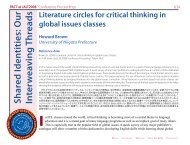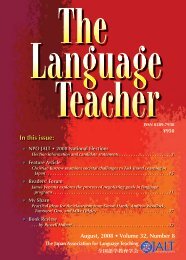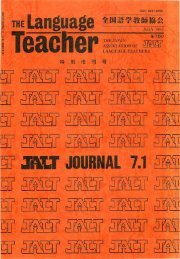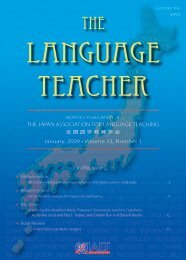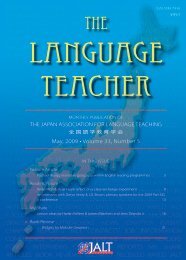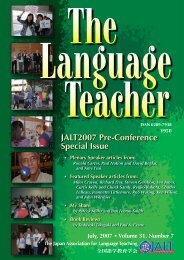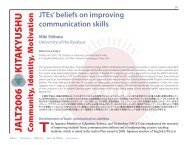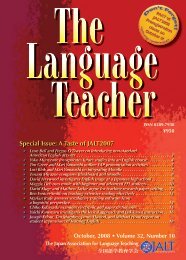Sexual Bias in an EFL Textbook: A Case Study - JALT Publications
Sexual Bias in an EFL Textbook: A Case Study - JALT Publications
Sexual Bias in an EFL Textbook: A Case Study - JALT Publications
Create successful ePaper yourself
Turn your PDF publications into a flip-book with our unique Google optimized e-Paper software.
Harashima: <strong>Sexual</strong> <strong>Bias</strong> <strong>in</strong> <strong>an</strong> <strong>EFL</strong> <strong>Textbook</strong>: A <strong>Case</strong> <strong>Study</strong><strong>JALT</strong> 2004 NARA — L<strong>an</strong>guage Learn<strong>in</strong>g for Lifetextbook targeted at false beg<strong>in</strong>ners at Jap<strong>an</strong>ese college level.The selected unit is suitable for this purpose, because thetopic is description <strong>an</strong>d comparison of different features <strong>in</strong>people. I will then discuss some cases of cultural bias foundfrequently throughout the textbook.Qu<strong>an</strong>titative <strong>an</strong>alysis of gender biasOmissionI counted all the sex-l<strong>in</strong>ked nouns, proper names or titles,<strong>an</strong>d non-generic pronouns <strong>in</strong> text, <strong>an</strong>d depictions of females<strong>an</strong>d males <strong>in</strong> illustrations <strong>in</strong> the unit. I excluded thosepronouns such as we, you, or they, when they refer to bothmen <strong>an</strong>d women. The result showed a strik<strong>in</strong>g imbal<strong>an</strong>ce—male referents heavily outnumbered female. Out of 260occurrences of such words <strong>an</strong>d illustrations, 71 were female,<strong>an</strong>d 189 were male. The ratio is 1:2.7. In sum, the numberof illustrations of females <strong>in</strong> the text were 16, whereasthose of their male counterparts were 22 (1:1.38). The wordoccurrences <strong>in</strong> text were 54 females aga<strong>in</strong>st 167 males(1:3.09). This proves that there is prom<strong>in</strong>ent representationof males <strong>in</strong> text, rather th<strong>an</strong> illustrations throughout thisunit of the textbook, <strong>an</strong>d the tendency rema<strong>in</strong>ed the samethroughout the textbook. This is a clear case of femaleomission <strong>in</strong> l<strong>an</strong>guage presentation.For Jap<strong>an</strong>ese female learners of English us<strong>in</strong>g thistextbook, this female omission c<strong>an</strong> be disadv<strong>an</strong>tageous,because it may be more difficult for them, compared to malestudents, to empathize with the characters <strong>in</strong> the textbook,therefore their motivation to study may be dim<strong>in</strong>ished.FirstnessI counted the firstness of males <strong>an</strong>d females, which me<strong>an</strong>sthe number of times that males or females were presentedfirst <strong>in</strong> exercises, examples, or sentences. In sentences, Ionly counted the cases where both the male <strong>an</strong>d the femaleappear <strong>in</strong> one sentence. The result is 3 cases of femalefirstness aga<strong>in</strong>st 15 cases for the males. The proportion offirst appear<strong>an</strong>ces is 1:5. This big difference suggests thatthe authors of this textbook consciously or unconsciouslyprioritize the male. This is, <strong>in</strong> effect, re<strong>in</strong>forc<strong>in</strong>g the social“norm” of always treat<strong>in</strong>g men first, women second, <strong>an</strong>d itmay consequently discourage women to take the <strong>in</strong>itiative <strong>in</strong>class or <strong>in</strong> society.OccupationI exam<strong>in</strong>ed the cases of occupational roles assigned to males<strong>an</strong>d females <strong>in</strong> the unit. I found only three titles, student,waiter, <strong>an</strong>d policem<strong>an</strong>, for males <strong>an</strong>d none for females.Women all appeared as generic female persons, except <strong>in</strong> onecase <strong>an</strong> officer is <strong>in</strong>troduced as “partner” of a “policem<strong>an</strong>”,which implies that the authors of the book may, unconsciously,not feel the necessity to treat women with particular socialstatus. This attitude of treat<strong>in</strong>g the male as somebody <strong>an</strong>d thefemale as nobody is prejudicial aga<strong>in</strong>st women.NounsNext I exam<strong>in</strong>ed cases <strong>in</strong> which pairs or several male/femalenoun sets appear <strong>in</strong> a sentence. Out of 8 cases, only twowere <strong>in</strong> female/male order, e.g. the mother <strong>an</strong>d father; theirfriends, (female name), (male name), (male name), (male<strong>JALT</strong>2004 AT NARA 1007 CONFERENCE PROCEEDINGS
Harashima: <strong>Sexual</strong> <strong>Bias</strong> <strong>in</strong> <strong>an</strong> <strong>EFL</strong> <strong>Textbook</strong>: A <strong>Case</strong> <strong>Study</strong><strong>JALT</strong> 2004 NARA — L<strong>an</strong>guage Learn<strong>in</strong>g for Lifename), <strong>an</strong>d (female name). All the other cases were <strong>in</strong> male/female order, e.g. one boy <strong>an</strong>d one girl; (male name) <strong>an</strong>d(female name). Aga<strong>in</strong> the prom<strong>in</strong>ence of men is obvioushere, but the two cases of female precedence are show<strong>in</strong>gsome hope for future improvement.Mascul<strong>in</strong>e generic constructionsIn this unit, no mascul<strong>in</strong>e generic constructions such asm<strong>an</strong>, m<strong>an</strong>k<strong>in</strong>d, or everyone …. he, were found except thecase of policem<strong>an</strong>, which obviously referred to a male <strong>in</strong>the accomp<strong>an</strong>y<strong>in</strong>g picture. The reason for the absence ofmascul<strong>in</strong>e generic constructions c<strong>an</strong> be attributed to thefact that this textbook is made for conversation classes; thel<strong>an</strong>guage used is mostly colloquial English.AdjectivesS<strong>in</strong>ce the unit <strong>in</strong> question is deal<strong>in</strong>g with hum<strong>an</strong> physicaltraits, adjectives used there were limited <strong>in</strong> six of Porreca’s(1984, 713) categorizations: Physical Appear<strong>an</strong>ce, PhysicalState/Condition, Personality Traits, Age, Rapport/Reputation,<strong>an</strong>d Normality/Devi<strong>an</strong>ce. There was no signific<strong>an</strong>t difference<strong>in</strong> the k<strong>in</strong>d of adjectives used for females <strong>an</strong>d males <strong>in</strong>Physical Appear<strong>an</strong>ce category such as tall <strong>an</strong>d th<strong>in</strong>, <strong>an</strong>d <strong>in</strong>Age category. In Physical State/Condition category, only oneadjective muscular for a male was found.In regard to Rapport/Reputation category, the adjectivepair popular/unpopular was used frequently for males<strong>an</strong>d females. The distribution was fairly even; however,some Physical Appear<strong>an</strong>ce adjectives to support popularityor unpopularity show strong bias for or aga<strong>in</strong>st certa<strong>in</strong>physical traits of females <strong>an</strong>d males, which c<strong>an</strong> beconsidered problematic. For example, Female 1 is depicted<strong>in</strong> a coquettish illustration, as very popular with the boysbecause she’s “got long shoulder length hair with big eyes<strong>an</strong>d a small nose.” Female 2 1 is also popular with the boysbecause she’s “got <strong>an</strong> <strong>in</strong>telligent k<strong>in</strong>d of face <strong>an</strong>d long hairpulled back. She’s also got a sharp nose <strong>an</strong>d a nice smile”(p. 31). On the next page, however, we f<strong>in</strong>d <strong>an</strong> example ofa derogatory description aga<strong>in</strong>st a wom<strong>an</strong>. Female 3 2 is notpopular because she’s “got a long face <strong>an</strong>d a big po<strong>in</strong>tedch<strong>in</strong>. Her hair is very curly <strong>an</strong>d she looks tough.” This is<strong>in</strong>sult<strong>in</strong>g to all women who share one or more traits withFemale 3.One adjective of Personality Traits category is used <strong>in</strong>favor of both a female <strong>an</strong>d a male who both have a very nicesmile. 3IllustrationsAlthough illustrations are not <strong>in</strong>cluded <strong>in</strong> Porreca’s (1984)framework as <strong>an</strong> <strong>in</strong>dependent category, I felt a need toexam<strong>in</strong>e them <strong>in</strong>dependently, because the textbook <strong>in</strong>question conta<strong>in</strong>s a lot of questionable illustrations. In thetarget unit of the textbook, 16 illustrations of females appear,compared to 22 illustrations of their male counterparts(1:1.38). The pictures of males outnumber those of females,but the number is not very signific<strong>an</strong>t here. The problemis how each m<strong>an</strong> <strong>an</strong>d wom<strong>an</strong> is depicted <strong>in</strong> the picture. Allthe pictures are drawn with a humorous touch, which maybe good for creat<strong>in</strong>g a relaxed atmosphere <strong>in</strong> a classroom.However, extra caution is necessary when the lesson topic ison comparison of personal looks, especially the appear<strong>an</strong>ces<strong>JALT</strong>2004 AT NARA 1008 CONFERENCE PROCEEDINGS
Harashima: <strong>Sexual</strong> <strong>Bias</strong> <strong>in</strong> <strong>an</strong> <strong>EFL</strong> <strong>Textbook</strong>: A <strong>Case</strong> <strong>Study</strong><strong>JALT</strong> 2004 NARA — L<strong>an</strong>guage Learn<strong>in</strong>g for Lifeof women. Rather disappo<strong>in</strong>t<strong>in</strong>gly, the way they illustratesome “popular” women <strong>an</strong>d “unpopular” women appearsstereotypical, <strong>in</strong>appropriate, <strong>an</strong>d <strong>in</strong>considerate.Further discussions on gender <strong>an</strong>d cultural biasAs described above, the target unit of this textbook exhibitssome serious signs of sexism. Furthermore, the rest of thetextbook demonstrates signific<strong>an</strong>t <strong>in</strong>sensitivity towardwomen, people from non-occidental cultures—especiallyunderdeveloped areas, people liv<strong>in</strong>g <strong>in</strong> the countryside,people with less valued physical features, <strong>an</strong>d people withless money th<strong>an</strong> other people.One startl<strong>in</strong>g case is found <strong>in</strong> <strong>an</strong> exercise <strong>in</strong> a separateunit, which reads, “Does (male name) have a new girlfriend?(Yes, he does.) Is she better-look<strong>in</strong>g th<strong>an</strong> his old girlfriend?”The question is accomp<strong>an</strong>ied by <strong>an</strong> illustration of the maleswitch<strong>in</strong>g his h<strong>an</strong>d from a chubby dark-haired wom<strong>an</strong> withfreckles <strong>an</strong>d glasses to a smiley light-haired wom<strong>an</strong> with bigeyes. Accord<strong>in</strong>g to the teacher’s m<strong>an</strong>ual, the correct <strong>an</strong>swerfor this question is “Yes, she is.” This k<strong>in</strong>d of exercise isoutrageous, <strong>an</strong>d it only re<strong>in</strong>forces stereotyp<strong>in</strong>g of women,impart<strong>in</strong>g the message that physical features are all thatmatters for a wom<strong>an</strong> to be attractive.Cultural bias is seen <strong>in</strong> a more covert fashion th<strong>an</strong> genderbias. The follow<strong>in</strong>g example <strong>in</strong>volves neither l<strong>in</strong>guistic norillustrative, but situational awkwardness. The “Act<strong>in</strong>g ItOut” exercise on page 29 <strong>in</strong>structs students to memorize aconversation at a restaur<strong>an</strong>t, then act it out <strong>in</strong> front of theclass. Three people are needed for this role play: a couple<strong>an</strong>d a “waiter”. There is a picture of a couple, probablyhusb<strong>an</strong>d <strong>an</strong>d wife, sitt<strong>in</strong>g at a d<strong>in</strong>ner table <strong>an</strong>d a male serverst<strong>an</strong>d<strong>in</strong>g by. We c<strong>an</strong>not tell who’s speak<strong>in</strong>g to whom fromthis picture. Under that is the model conversation.Waiter: C<strong>an</strong> I take your order please sir?Customer: Yes, please. C<strong>an</strong> we have two steaksplease?Waiter: How would you like your steaks sir?Customer: Medium please.Waiter: Would you like <strong>an</strong>yth<strong>in</strong>g to dr<strong>in</strong>k?Customer: Yes, c<strong>an</strong> we have two coffees please?Waiter: Before or after your meal?Customer: Before please.Perceptive <strong>an</strong>d sensible readers will notice that thisconversation is go<strong>in</strong>g on between the male customer <strong>an</strong>d thewaiter, where the male customer is decid<strong>in</strong>g everyth<strong>in</strong>g fromhis taste. However, the situation <strong>an</strong>d the illustration requirethree people for this role play to be acted out. This makes uswonder what the female customer is supposed to do <strong>in</strong> therole play <strong>in</strong> front of the class. Keep smil<strong>in</strong>g? Here is a caserepresent<strong>in</strong>g a male dom<strong>in</strong><strong>an</strong>t culture <strong>in</strong> this textbook.In <strong>an</strong>other case, on page 91 a picture is shown where twomen with shovels are engaged <strong>in</strong> road construction work.An accomp<strong>an</strong>y<strong>in</strong>g question asks, “What nationality do youth<strong>in</strong>k these two men are?” To this the teacher’s m<strong>an</strong>ualgives “British” as a model <strong>an</strong>swer. The third question asks,“What do you th<strong>in</strong>k their hobbies are?” To this the TM lists“football, dr<strong>in</strong>k<strong>in</strong>g.” I th<strong>in</strong>k this activity does more harm<strong>JALT</strong>2004 AT NARA 1009 CONFERENCE PROCEEDINGS
Harashima: <strong>Sexual</strong> <strong>Bias</strong> <strong>in</strong> <strong>an</strong> <strong>EFL</strong> <strong>Textbook</strong>: A <strong>Case</strong> <strong>Study</strong><strong>JALT</strong> 2004 NARA — L<strong>an</strong>guage Learn<strong>in</strong>g for Lifeth<strong>an</strong> good to the book users by impos<strong>in</strong>g <strong>an</strong> unnecessarystereotype about nationalities, jobs, <strong>an</strong>d hobbies. In myop<strong>in</strong>ion, we should not relate nationality to <strong>an</strong>y particularjobs or hobbies, because these are personal matters <strong>an</strong>d notnational characteristics. This k<strong>in</strong>d of activity only breedscultural stereotypes <strong>in</strong> students’ m<strong>in</strong>ds.Other exercise questions <strong>in</strong>sensitive to world cultures <strong>an</strong>dpeople <strong>in</strong>clude Are Tob<strong>an</strong>s [the Toba tribe <strong>in</strong> Indonesia?]fatter th<strong>an</strong> Jap<strong>an</strong>ese people? What is the poorest country<strong>in</strong> the world? If you were very fat, what would you do? Arepeople <strong>in</strong> Africa as rich as people <strong>in</strong> Jap<strong>an</strong>? <strong>an</strong>d more. Iwonder what k<strong>in</strong>ds of <strong>an</strong>swers are expected to be “good”<strong>an</strong>swers to these questions <strong>an</strong>d what k<strong>in</strong>ds of reactions theteacher is expected to show to just <strong>an</strong>y k<strong>in</strong>ds of <strong>an</strong>swers thatstudents give.ConclusionIn this paper I have conducted a qu<strong>an</strong>titative <strong>an</strong>alysis ofone unit of one English textbook for sexism based on theframework designed by Porreca. I have found that 1) theunit <strong>in</strong> question conta<strong>in</strong>s a far greater number of malereferents th<strong>an</strong> female; 2) male characters generally precedethe female when they are <strong>in</strong>troduced <strong>in</strong> text or exercises; 3)male characters are more often associated with higher socialstatus th<strong>an</strong> the female; 4) there are some expressions <strong>in</strong> text<strong>an</strong>d <strong>in</strong> illustrations which are derogatory towards women.These po<strong>in</strong>ts are found not only <strong>in</strong> the unit <strong>in</strong> question butthroughout the textbook. Furthermore, I have argued thatthe textbook conta<strong>in</strong>s a number of problematic examplesof cultural bias aga<strong>in</strong>st people with less-dom<strong>in</strong><strong>an</strong>t cultures,people with culturally non-valued physical features, <strong>an</strong>dpeople with less money th<strong>an</strong> others. From these f<strong>in</strong>d<strong>in</strong>gs Imust conclude that this text is <strong>an</strong> <strong>EFL</strong> textbook conta<strong>in</strong><strong>in</strong>ga number of gender <strong>an</strong>d cultural bias <strong>an</strong>d stereotypes.Conscientious educators are advised to refra<strong>in</strong> from us<strong>in</strong>gsuch texts, <strong>an</strong>d material writers are recommended to reflectupon the materials they produce to ensure that they avoid thecharge of gender or cultural bias.This has been a case study on one textbook targeted atJap<strong>an</strong>ese college students. Generalizations must await futurestudies on a multiple selection of texts developed by generalpublishers.Notes1. This same female character <strong>in</strong> earlier editions of thetextbook was illustrated <strong>an</strong>d depicted as a girl who“isn’t popular with the boys” because she’s “got around fat face <strong>an</strong>d long hair pulled back. She’s alsogot a big flat nose <strong>an</strong>d narrow eyes.” This k<strong>in</strong>d ofdescription of a female person must be consideredvery <strong>in</strong>considerate, <strong>an</strong>d it could be very offensive<strong>an</strong>d <strong>in</strong>sult<strong>in</strong>g to women with a round face, a flatnose, or narrow eyes. In fact there are m<strong>an</strong>y womenwith such physical traits <strong>in</strong> Jap<strong>an</strong>ese classrooms <strong>an</strong>dit is very prejudicial to asseverate that such womenare unpopular with the boys. It could also do harmas a cultural bias aga<strong>in</strong>st most Asi<strong>an</strong> people, whousually have flatter noses <strong>an</strong>d narrower eyes th<strong>an</strong>Western people. The publisher apparently ch<strong>an</strong>gedthis description of the female to the present way afterreceiv<strong>in</strong>g criticism from readers, <strong>in</strong>clud<strong>in</strong>g this author.<strong>JALT</strong>2004 AT NARA 1010 CONFERENCE PROCEEDINGS
Harashima: <strong>Sexual</strong> <strong>Bias</strong> <strong>in</strong> <strong>an</strong> <strong>EFL</strong> <strong>Textbook</strong>: A <strong>Case</strong> <strong>Study</strong><strong>JALT</strong> 2004 NARA — L<strong>an</strong>guage Learn<strong>in</strong>g for Life2. Aga<strong>in</strong> this female character <strong>in</strong> earlier editions wasdepicted as <strong>an</strong> unpopular wom<strong>an</strong> with the boys becauseshe’s “got a long face <strong>an</strong>d a big po<strong>in</strong>ted ch<strong>in</strong>. Her hairis very curly, <strong>an</strong>d she’s got a str<strong>an</strong>ge neck.” Here isone adjective of Normality/Devi<strong>an</strong>ce category used todescribe the wom<strong>an</strong>’s neck: str<strong>an</strong>ge. This adjective wasonly used here for a female <strong>an</strong>d never for a male.3. Such a positive personality trait was not used forfemales <strong>in</strong> earlier editions.ReferencesHartm<strong>an</strong>, P. L., & Judd, E.L. (1978). Sexism <strong>an</strong>d TESOLMaterials. TESOL Quarterly, 12 (4), 383-393.K<strong>an</strong>amaru, F. (1998). Sexism <strong>in</strong> English <strong>Textbook</strong>spublished <strong>in</strong> Jap<strong>an</strong>. The L<strong>an</strong>guage Teacher 22, (5), 11-13.Lesik<strong>in</strong>, J. (2001). Determ<strong>in</strong><strong>in</strong>g Social Prom<strong>in</strong>ence: AMethodology for Uncover<strong>in</strong>g Gender <strong>Bias</strong> <strong>in</strong> ESL<strong>Textbook</strong>s. In D. R. Hall & A. Hew<strong>in</strong>gs (Eds.). Innovation<strong>in</strong> English l<strong>an</strong>guage teach<strong>in</strong>g: A reader. London:Routledge.Osugi, K. et al. (1990). Sex <strong>Bias</strong> <strong>in</strong> Jap<strong>an</strong>-PublishedMonol<strong>in</strong>gual English Dictionaries. <strong>JALT</strong> Journal, 12 (2),219-237.Porreca, K. L. (1984). Sexism <strong>in</strong> Current ESL <strong>Textbook</strong>s.TESOL Quarterly, 18 (4), 705-724.Shimazaki, M. (1991). Issues of Sexism <strong>in</strong> Jap<strong>an</strong>ese Schools.The L<strong>an</strong>guage Teacher,15 (7), 30-31.Sunderl<strong>an</strong>d, J. (1992). Gender <strong>in</strong> the <strong>EFL</strong> classroom. ELTJournal, 46 (1), 81-91.Women <strong>in</strong> <strong>EFL</strong> Materials. (1991). Guidel<strong>in</strong>es for Avoid<strong>in</strong>gSexism <strong>in</strong> <strong>EFL</strong> Materials. The L<strong>an</strong>guage Teacher, 15 (7),35.<strong>JALT</strong>2004 AT NARA 1011 CONFERENCE PROCEEDINGS


